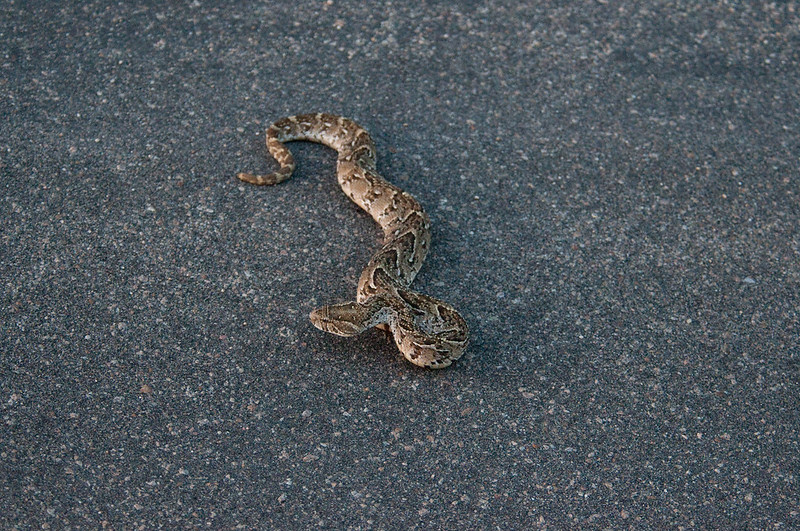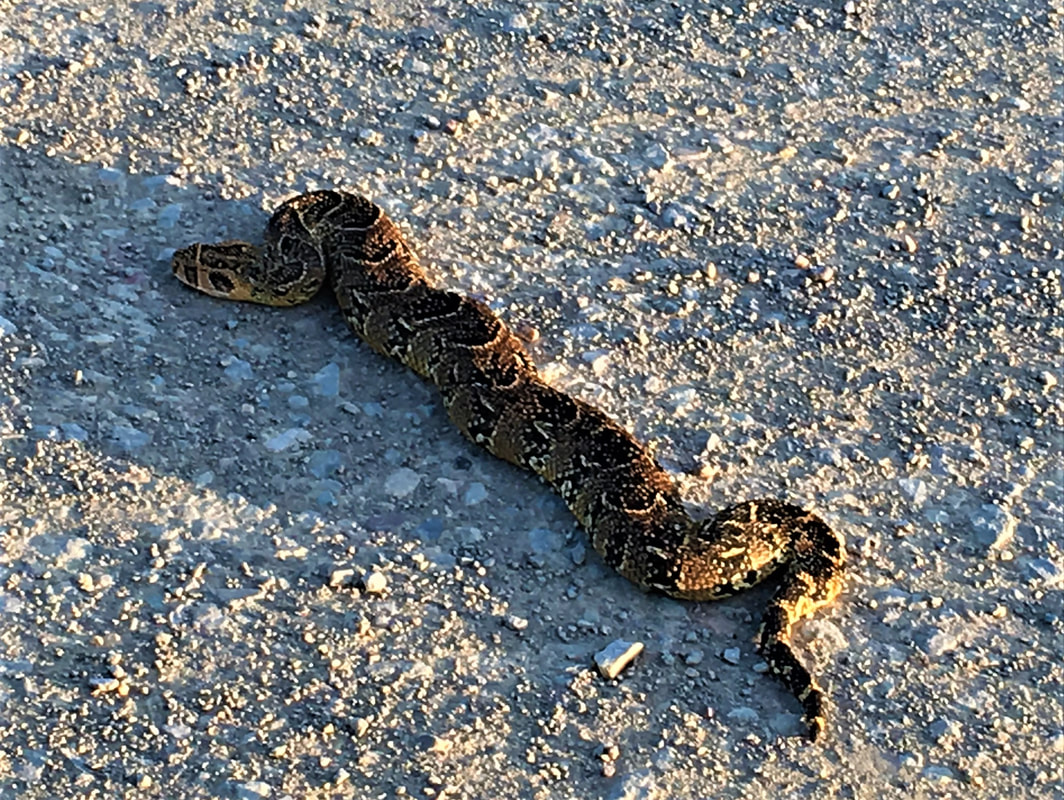|
Other names: Pofadder, Imbululu Classification: very dangerous Snakes are fascinating reptiles that are sometimes unnecessarily feared by field, forestry, and other outdoor workers. Puff adders are widely distributed throughout South Africa and northern Africa (African Snakebite Institute), and we are delighted to have a number of these beautiful creatures in and around the conservancy. These short, stubby snakes have V-shaped patterns on their bodies and a triangular head that is unique from the rest of their bodies (Umbono training, 2014). Puff adders have a large body and use camouflage to hide. A puff adder's life is mostly spent in camouflage mode (African snakebite institute). On the ground, puff adders move slowly, although they will climb small plants to get sunlight (Marais, 1999). They are “ambush hunters” who will coil up into a striking position and wait for prey to approach (African snake bite institute). This snake is very active after sunset and comes out of vegetation towards the road to bake in the sun. This often means that they are, sadly, often driven over by vehicles (Marais, 1999). They usually feed on rats and mice as well as other small land mammals, including, ground birds, lizards, toads. The puff adder follows the scent of its prey with its flashing tongue, with sensors, and then catches its prey (Marais, 1999). Reproduction Puff adders give birth to approximately 20-40 snakes, usually after summer. The hatchlings are approximately 15-20 cm long and are born in a fine membranous sac, from which they break shortly after birth (African snake bite institute).Go to https://www.africansnakebiteinstitute.com/ -for more intresting reading on puff adders and other snake species. Threats to these lovely beasts Habitat loss is one of the factors that place puff adders in jeopardy. This includes, fragmentation, degradation of land, as well as agricultural expansion. Alien vegetation is not a direct threat to puff adders, but alien vegetation increases the risk of wildfires which can pose a threat to snakes. Alien vegetation does therefore impact these creatures (Branch, 2014). Twakkie, are knowledgably quality controller at the conservancy, is of the opinion that snakes are generally feared because their venom has the potential to kill humans. However, snakes seldom actually strike and therefore their danger is exaggerated Snakes are also often killed because of urban legends or superstitions that vary in different cultures and religions. Superstitions about snakes I am a coloured, Baptised Christian from the Knysna area. In my religion, snakes are associated with the devil, and it is said that the snake was a traitor, associated with evil, and sent by the devil in the days of Adam and Eve. When I asked other employees about some myths they know about or believe in their faith or culture, Twakkie said that in the bible it states that a snake will bite your heels and the man will knock his head. Twakkie also revealed that he is aware of a legend in which Satan is depicted as a serpent. Another employee, Linda, who works as the administrator in the conservancy, says there's a myth that if you find one snake in your house, you'll find more because snakes travel in pairs. I also asked Ndukwenthle, who is from Swaziland and works on one of the farms in the conservancy. He said that some people in his culture eat snakes and use snakes for black magic. He said some people believe that you should kill them before they kill your child. Apparently, it is believed that snakes can smell fresh milk and that children are usually around milk and so they might get bitten by snakes. With all these superstitions associated with snakes, we need to work extra hard to protect them. As a conservancy, it is our job to conserve our biodiversity and establish a sustainable environment in terms of conservation. Here is some useful information to help better understand snakes, the real risks they pose and how to treat a bite if it does occur. Snakes are not aggressive unless provoked People do not see puffadders because of their camouflage, and as a result, the puffadder is responsible for at least 60% of snake bites in South Africa. There is a myth which states that snakes are always aggressive which is not true. Snakes aren't hostile, and they don't pursue humans. When they are disturbed, most snakes flee (Strydom and Schoeman, 2016). Snakes will not chase you, contrary to popular belief. If you happen to come across a snake, don't try to kill it. Stand stationary; snakes will not attack you. It is best to retain a safe distance of at least 5 meters or more (Umbondo training, 2014). If you see a snake, don't try to kill it; instead, keep a watch on it and call the appropriate authorities if it needs to be removed (Marais, 1999). Furthermore, treat all creatures with respect by leaving a dead snake alone. Sometimes snakes will pretend to be dead and may then become aggressive if provoked or prodded. Understanding venom and snake bites In South Africa, many snakebites occur during the summer months, from January to May. Puff adder or rhombic Night adder bites account for over 90% of snake bites in South Africa (Strydom and Schoeman, 2016). The most common types of venom found in snakes are cytotoxic, neurotoxic, and hemotoxic venom. Each of these different venoms attacks a different organ or system in the body and its useful to understand the differences. Cytotoxic venom destroys cells and affects tissue and blood cells. Severe pain and swelling around the bite region are possible side effects of cytotoxic venom. Some of the snakes with this venom is puff adders (Bitis arientans), Gaboon viper(Bitis gabonica), horned adder(Bitis caudalis), Rhombic night adder(Causus rhombeatus). The nervous system gets poisoned by neurotoxins. Paralysis, convulsions, or rapid muscle twitching are all symptoms of neurotoxic venom, which can also cause trouble breathing and other respiratory problems. Some snakes with this venom are the berg adder (Bitis atropos), Black mamba (Dendroaspis polylepis), Green mamba (Dendroaspis angusticeps), Cape cobra (Naja nivea). Swelling, internal bleeding, and haemorrhaging necrosis are symptoms of hemotoxic venom. This is caused by poisoning of the circulatory system or bloodstream (Umbono training, 2014). Some snakes that have this venom is Boomslang (Dispholidus typus). The Cytotoxic Venom from a puff Added will not cause immediate death Puff adder venom is extremely cytotoxic, attacking blood tissues and cells. Serious pain, significant swelling, and occasionally blistering at the bite site are all indicators of being bitten. (Marais, 1999). Polyvalent antivenom is effective and should be used as soon as possible (African snakebite institute). Fatalities are uncommon (African snake bite institute) since the puff adder is usually straightforward to identify and treat with antivenom. Most of the victims are bitten on the lower leg. If victims are not treated or if treatment is unsuccessful, the poison takes longer to function and can take up to 24 hours or more before they die. It is unusual for the victim to die in a short amount of time (Marais, 1999), because puff adders have a cytotoxic venom that takes time to work (Marais, 1999) (Strydom and Schoeman, 2016). When bitten by a puff adder, what signs and symptoms may you expect? Inflammation and swelling in the bitten regions, as well as a change in skin colour (Strydom and Schoeman, 2016). Excessive swelling is the most common cause of fatal bites. Antidote should be provided in extreme circumstances (Strydom and Schoeman, 2016). Because most bites occur on the lower leg or ankle, wearing boots, long pants, and leg protection are effective measures to avoid being bitten. Keep your eyes open and don't put your hand in a place where you won't be able to see. Large rocks should be walked on, not over. If you are bitten, stay calm, and try to and identify the snake. Identification of the snake will help to ensure the right anti-venom is administrated. Go to the doctor or local clinic right away as anti-venom is required (Strydom and Schoeman, 2016). First aid procedures for a puff adder snake bite
References
Branch, W.R., 2014. Conservation status, diversity, endemism, hotspots and threats. Atlas and Red List of the Reptiles of South Africa, Lesotho and Swaziland. Suricata, 1, pp.22-50. https://www.africansnakebiteinstitute.com/ Marais.,J Slange & Slangbyte in Suider-Afrika .,1999 ,Kaapstad Nielsen, A., Fatalities, Attacks, Teeth, and Fangs. Strydom and Schoeman, Fransmanshoek Conservancy.,2016., Season, S., Compliance Management.
0 Comments
|
AuthorGVB Conservancy Staff Archives
May 2024
Categories |



 RSS Feed
RSS Feed






